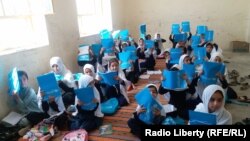LASHKAR GAH, Afghanistan – The Afghan government and its Western allies often project the return of millions of girls to schools as one of their major achievements after the hard-line Taliban regime had banned girls’ education.
But nearly 18 years after the overthrow of the Taliban and tens of billions of dollars in aid, not a single girl has graduated from a high school in most districts of Afghanistan’s largest province.
Officials in Helmand say that apart from the capital, Lashkar Gah, and the adjacent district of Greshk, female students in the remaining 12 districts of the vast southern province bordering Pakistan have not finished 12th grade. The country’s educational system requires students to finish high school before applying to universities and professional schools.
Muhammad Daud Shah Safari, the director of the Education Ministry for Helmand, says insecurity and the Taliban’s opposition to educating girls beyond elementary school are two of the major reasons preventing girls from graduating from high school.
“We do not have enough women teachers,” he told Radio Free Afghanistan. “Poverty, early marriage, distance from the schools, and the destruction or lack of school buildings are other contributing factors preventing girls from completing high school.”
Safari says that while tens of thousands of girls among the province’s estimated 900,000 residents join elementary schools, very few complete all 12 years of education. Helmand’s directorate of education estimates that, so far, only 4,000 girls have graduated high school in the province.
Wajiha Rasuli, the head of the Women’s Affairs Ministry in Helmand, argues that the quick-fix attitude that often resulted in funding short-term projects after the fall of the Taliban regime has failed to deliver long-term gains in women’s education and rights in the Afghan countryside.
“We have not implemented major programs aiming at raising public awareness about girls’ education in most of the districts here,” she told Radio Free Afghanistan. “To me, this is a major reason we don’t have many female high-school graduates in many [rural and conservative] districts.”
Rasuli says that insecurity due to nearly constant fighting between insurgents and the government and international forces cannot be portrayed as the key reason stopping girls from obtaining education. She says that both Lashkar Gah and Greshk have had their share of Helmand’s violence.
Helmand, the size of Switzerland, has been a key Taliban bastion since the emergence of the hard-line Islamist movement in neighboring Kandahar in the 1990s. The movement still relies on the region’s drug trade and manpower to bankroll its violent campaign.
During the insurgency’s initial years following the demise of the Taliban regime in late 2001, the insurgents blew up scores of schools across Helmand. But as the insurgency gained strength after the departure of most NATO troops in 2014, the Taliban began to control territories. They currently control or contest 12 of Helmand’s 14 districts.
While the Taliban have allowed the government to continue providing limited healthcare and education, they tightly control all aspects of life in these territories and residents are even not allowed to even listen to music or radio.
Attaullah Afghan, head of the provincial council in Helmand, is urging the authorities to invest in education by first upgrading the current elementary and middle schools to include high schools.
“We quickly need to increase the number of available classrooms in the countryside,” he told Radio Free Afghanistan. “Once we have enough high-school graduates in these districts, we will see them join the seats of high education.”
According to the Afghan Education Ministry, there are 422 schools in Helmand. Out of these, only 19 are exclusively for girls. At least 70 schools across the region are currently closed. Officials in Helmand say that to cater to the current number of potential students in the province they need at least 2,800 more teachers.
To help more girls in Helmand finish high school, women should make up a large number of these new teachers.
Abubakar Siddique wrote this story based on Radio Free Afghanistan correspondent Mohammad Ilyas Dayee's reporting from Lashkar Gah, Afghanistan.






